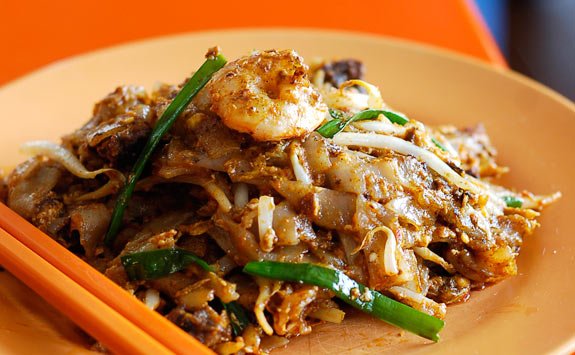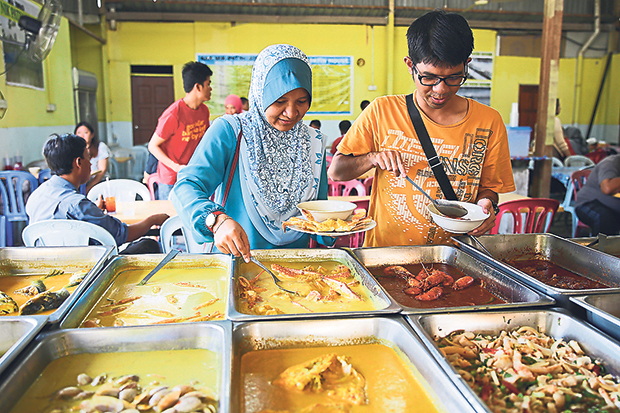About My Culture: The Mixed Culture in Malaysia - Rojak-ness
I came across this #AboutMyCulture challenge by @sndbox member @aaronli. Its purpose is for us to learn about each other's culture through Steemit. You may read more about the challenge here. Thank you for this challenge to share more about the culture I am in. I was thinking maybe this will be a great opportunity to share about the mixed culture we have here in Malaysia and how it impacts us deeply. It has somehow become our identity. I reckon it will not be an easy subject to write on (because it requires explanation on the local slangs) but I hope I do not confuse you and am able to bring you through.
The Rojak Culture

Image Source This is how a dish called rojak looks like in Malaysia. In a local slang, it would mean mixing things from different sources together to create something unique. We tend to say that the way we speak is very rojak because we have infused all the different main languages into our culture. We also share a rojak eating culture as we eat from each other's food a lot.
My topic is on the rojak culture I am living in. It is a culture I was born into and intend to raise my children in. Let me expound more on this culture as you follow me through this post.
Why I chose this culture to post about?
I was raised in this culture where my Indian neighbour spoke Hokkien Chinese fluently (even better than myself) and babysat my Chinese and Malay neighbours, so much so they called her "godmum". I love this part since I was young and we played together.
When I traveled to China some years ago, the Chinese as well as some expats residing in China whom we got to know were quite amazed that I, a Malaysian Chinese can speak the Mandarin Chinese quite fairly, though not excellent. They were even more amazed that I am educated in three languages: Malay (our national official language), Mandarin Chinese and English. It may differ from one citizen to another, depending on their upbringing though. This wakes me up to appreciate a culture I am in.
Introduction of Malaysia as a multi-racial country

Image Source
Malaysia is a multi-racial country which was also colonized by the Japanese, British, Dutch and Portugese. We were also formed as a nation with many different existing races' ancestors who migrated over here many decades ago. In our country, there are three main races: Malay, Chinese and Indian but there are also many more indigenous tribes like the Ibans, Bidayuh, Kadazans, Kayans, Muruts so on and so forth. This results in a GREAT diversity in our culture. We do have our fair shares of differences and beliefs but we have been co-exisiting quite peacefully together and very much enjoying each other's culture. Not to mention, we are so blended in that there are many cross-racial marriages too.
Rojak, is a dish with vegetables and fruits, stirred in a black sauce made by either shrimp paste or palm sugar and topped with peanut bits or powder. Some would call it fruit salad but it can also be a spicy salad for the local liking. All the three main races actually make them in their own special ways. The usual Muslim Indian rojak is served with cuttlefish, fried fritters, boiled potatoes, hard boiled eggs and will be more spicy while the Chinese has their own rojak that is usually fruits like pineapple, fresh turnips, cucumber, deep fried to-fu, semi-riped mangoes and it is less spicy. However, we can see that there has been a slight merge between the two types throught the years and the Malaysians adore both! If you are interested in making rojak, you may refer the recipe here.

Image SourceCross-cultural marriages are common in Malaysia.
Rojak also carries another meaning locally, which is MIXTURE in Malay. It basically means fusion of all sorts. This is actually the main point I am trying to bring to the table - embracing our diversities and becoming more like each other.

The ROJAK language

Image Source
It is actually usual to hear a person from another race including the words from his non-mother tongue into his or her daily speaking in Malaysia.
Let me give you a scenario of asking to meet and eat in a local mamak (Muslim Indian eatery shop):
"Eh bro, later want to go yumcha (Cantonese Chinese word) at mamak? Come lah!"
(Translated as: Hey bro, let's go catch up and hang out at the mamak shop? Do come!)
As we place our order
"Ane (bro in Tamil), I nak makan mee goreng mamak, satu. Kasi satu telur."
(Translated as: Bro, I want to eat a plate of fried noodles mamakstyle, give me an added egg too.)
In just the scenario above, we have used our mixed language well enough and we usually do not even realize that.
Besides that, we too like every other culture elsewhere have developed our own local slangs like adding "lah", "leh", "meh" in our daily conversations. This is adapted across any race.

Image Source
For instance,
Don't like that lah.
(which means "Can you don't behave that way?" in a persuasive manner.)
Manglish has become so common that some may mistaken it as our new national language, haha. What is Manglish, you may ask? It is actually Malaysian- English, but with the mixture of Malay, Chinese (including dialects) and even some Indian Tamil words. Manglish's vast vocabulary is developed from English, Malay, Hokkien, Mandarin, Cantonese, Tamil, Malay. It is also a common language in Singapore as our culture is pretty similar. It is our informal language and is not used in our formal writing (or to be improved as I have caught my students using it pretty often which is a no,no to me!).
Common famous Manglish words are like terrer (meaning very good in something or very serious), cincai (meaning simply or casually doing something), sibeh (meaning very), gostan (reversing a car or vehicle), lepak (meaning hang out), agak-agak ( (meaning approximately) and etc. There is still a long list to go actually, like potong stim, pokai and so on which you can check it out here. It is very interesting if you are curious to find out.

ROJAK adaptations in Food
.jpg)
Image Source
Someone was mentioning to me that Malaysians are often mentioned and tied closely with food, which leads me to this subtopic on how we are quite rojak in our food as well.
In our country, Malays have some restrictions on some food, due to their beliefs so they refrain from pork. Besides that, I think we basically share everything. It is not a shock to see a Malay adapting a Chinese recipe to sell it in his or her shop and Chinese and Indians would also be doing that. They may even elevate the taste of that food to a higher level.
Let me give you an example:
We have fried flour noodle here which is known as "kway teow", or "hor fun" in Cantonese Chinese, which I think is supposedly originating from the Chinese race.
The Malays can fry it very well and they came out with this dish called "kway teow basah" (which means fried "kway teow" with gravy). This dish is my ultimate favourite, and I am not even a Malay but a Malaysian Chinese.

Image SourceKway Teow basah
The Chinese have many different ways of cooking "kway teow" and one of the famous that we are known with is the wok-fried "kway teow".

Image SourceChinese wok-fried Kway teow
The Indians too have come out with their own mamak-style fried "kway teow". I can say we enjoy all!

Image SourceMamak style fried Kway teow
The Chinese operate shoplot kind of eating place which is known as kopitiam. It is a regular place visited by the local Chinese, Indians and the indigenous tribes. Malays may avoid this place because they serve pork. However, there are also some pork-free kopitiams of which they would have no apprehension from visiting.

Image SourceChinese kopitiam which is frequent by other races too.
There are local Malay stalls which sells awesome Malay cooking. They have also added some Chinese fried rice into their menu and it is available at almost every Malay stall.

Image SourceMalay eating place, which Chinese and Indians as well as the other minorities also love. My husband who is a Chinese is known to be hardcore die-hard fan. He eats with his bare hands, no different from a local Malay.
Basically, we would go to mamak to get many of these local food. They have different types of roti which is a type of bread served in various ways. I would say mamak is a symbol of unity, haha and they have united us all!

Image SourceRoti sold in mamak.

Why is this Rojak/Fusion Culture special to me and others?
We need to give each other the space to grow, to be ourselves, to exercise our diversity. We need to give each other space so that we may both give and receive such beautiful things as ideas, openness, dignity, joy, healing, and inclusion. ~Max de Pree
Source
What trigger me to write about this culture is I was paying attention to how we speak and how my 2-year-old child is starting to pick up. It is actually the beauty of our unique culture. It is something so beautiful about diversity that we may miss out and take it for granted. We also participate in different races' celebrations.
"Malaysia, Truly Asia" is a slogan the Tourism board has come out with to promote our country's diversity, meaning it carries significance of many different Asian nations all-in-one in our nation itself. We celebrate many festivals together, almost one for every month because of the variety of people we have, in which we too would dress up in traditional clothes not from our own race. The wide spread of our cuisines has obviously inspired a lot of fusion food. Besides that, for us to live harmoniously with each other is also a great delight. If you have come across Malaysians on Steemit, you may realize the way we speak is somewhat similar though we are different individually, whether we are Malay, Chinese, Indian, mixed with parents from different race or from the indigenous tribes. We would be able to understand each other though every state also has its own localized language.
I think what we have done is we take the best out of each subcultures to improvise it into our main culture. This results often in the betterment of the origins.
I guess in such a diverse culture, we have produced a new culture of our own. We are a bit different from the original countries our ancestors came from, but we have shared our specialties and incorporated them into a new culture. It is a beautiful thing to watch and observe. I always have a thing for diversity, and something that has birthed forth within diversity is definitely a gem for me and perhaps for my countrymen as well. It has become a heritage of being multicultural. I am proud to be part of this ROJAK culture!
.gif)
GIF Source
If you have been an expat staying here in Malaysia, would you like to express your thoughts on our rojak language? Also, if you are a tourist who have visited Malaysia, were you confused by our rojak language? Do share your thoughts with me in the replies below, for I am actually curious to know what kind of impression this rojak culture has given to you.
Note: All photos above are cited according to the respective sources, in which all photo credits go to the sources.








Animated Banner Created By @zord189

Ah, yours is good with food! Rojak is what makes us so special. We have a magical medium that can connect to different kind of materials, or culture, making it delicious and blend well. Haha
Thanks for dropping by @kimzwarch :) Haha I don't know if a foreigner would be confused reading my post because of the local language or not. Hopefully it was still spelled out in a way they can follow through and not get lost. I feel there is so much more to say about this culture, hopefully what I said is sufficient for now. Lol.
Thanks for explanation. I have not been to Malaysia but I found Singapore was similar in terms on the mixture of language. I came back from my holiday with my Malaysian friend speaking more like a Malaysian/Singaporean 😂😂 You have an amazing country filled with beautiful people and delicious food. I will visit one day! Thank you for sharing your culture with me!
Hahaha yes Singaporeans and us have this same tendency towards our speaking language. I find it amusing. Thanks for reading my post, hope I didn't lost you half way through because of the local language. Do come for a visit one day! Where are you from, @supernovastaffy? :)
I didn’t get too lost haha but it did bring me back to my travels in Singapore. I will definitely visit Malaysia sometime as my brother will be getting married there in a couple years if he actually starts to plan the wedding!
I am from Australia, born and raised here, but I have a Chinese background. My parents were born in East Timor, but my grandparents all originated from China.
Oh I see, so you are an Australian. Haha best wishes for your brother in getting married and may you find Malaysia a nice place to explore, despite our scorching hot weather here :P Enjoy some rojak when you make it here, @supernovastaffy :)
This post has been selected by Altruistic as a post of the day has been given an upvote.
You may join us on her discord server: https://discord.gg/KHB9eJk.
Please kindly upvote this comment in order to keep us helping plankton and minnows that their quality posts are undervalued.
Thanks for being a member!
Gosh, this looks good.
Thank you @vanessahampton :)
Thanks for sharing about your culture :)
You are welcome @marpa :)
very interesting mix of cultures! that's great to have. You and your family are very lucky that be exposed to different cultures, believes and FOOD! because that's the best way to get to know cultures, by food xD!!
That is why we are all so rojak haha. What a great effort you have put into this post. Great job Connie. 😍
Rojak representing Malaysian. I went to Taiwan 4 years ago, the taxi driver told us that if he heard we speak rojak language, it means that we are either from Malaysia or Singapore. XD